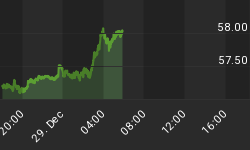Below are extracts from commentaries posted at www.speculative-investor.com on3rd November 2004 and 27th October 2004, respectively.
Low interest rates as far as the eye can see?
In his November Investment Outlook Bill Gross said: "My/our most certain idea, as expressed in previous Outlooks, is that real interest rates in the United States will have to be kept low, that the old Taylor rule [*] is out. Too much debt in a finance-based economy precludes raising interest rates like we have in the past and while that keeps the patient/economy breathing it leads to asset bubbles, potential inflation, and a declining currency over time."
Now, Mr Gross is the manager of the world's largest bond fund so when he makes a bold statement on interest rates we should certainly pay attention. However, is it likely, or even possible, that interest rates could remain low for a long time to come if we are correct in our assessment that the US has a major inflation problem?
In our opinion the answer is yes, emphasising that we are talking about low REAL interest rates and not low NOMINAL interest rates. The correct definition of the real interest rate is the nominal interest rate minus the EXPECTED inflation rate, so increases in nominal interest rates won't result in significantly higher real interest rates as long as inflation expectations are increasing at roughly the same pace.
In fact, when arguing the intermediate-term BULLISH case for the US$ in the 6th September Weekly Update we noted that it wasn't possible for us to be bullish on the dollar beyond the intermediate-term because "...the Fed's primary role is to perpetuate inflation and in order for the credit expansion to continue it will be necessary for real interest rates to remain low and for the yield-spread to remain wide. In other words, unless the Federal Reserve and the US Government are prepared to sit back and let the US experience 1-2 years of genuine deflation there will be a definite limit on the amount of monetary policy 'tightening' that will be attempted. And given that the US economy is already showing signs of weakness the aforementioned limit is probably not a great distance from where we are right now."
In other words, we agree with Bill Gross that the US economy is burdened with such a huge amount of debt that it could not sustain the level of REAL short-term interest rates that would typically be associated with a normal, healthy economy, with a ramification being a declining dollar over time.
There are, however, limits to what the Fed can do on the interest rate front and Mr Gross doesn't address these limits, perhaps because he doesn't currently foresee a major inflation problem. The main limit is the amount of currency depreciation the bond market will tolerate before it completely falls apart, because if long-term interest rates begin to surge upward in an uncontrolled manner the Fed will be FORCED to boost the nominal Fed Funds rate to the point where the REAL Fed Funds rate becomes high. It will be forced to do this because a runaway bond market -- assuming it is running away to the downside -- would present an even greater threat to the heavily indebted US economy than would a high real short-term interest rate.
Bonds: minimal upside potential + substantial downside risk
Over the past few years bonds have consistently trended higher whenever the US dollar has been trending lower. This is not, however, a situation we expect will continue for much longer because if the dollar keeps falling then it is bound to cause inflation expectations to rise. On the other hand, if the dollar starts to rise then the inter-market relationships that have dominated the financial markets over the past few years should ensure that bonds take a hit. In other words, regardless of what happens to the dollar we don't see much scope for bonds to advance from their current elevated level.
The following weekly T-Bond chart also supports the idea that bonds have minimal upside potential and are at risk of experiencing a sizeable decline. As you can see, bonds have just reversed lower after moving up to test intermediate-term resistance defined by the March-2004 peak.

Up until now we haven't been interested in betting against the bond market because we've thought there were better opportunities elsewhere. However, at the present time a bet against the US bond market looks a lot more interesting than a bet against the US stock market because the stock market's price action has been reasonably constructive and it is quite likely that the stock market will be able to rally for a while in the face of a falling bond market.
















